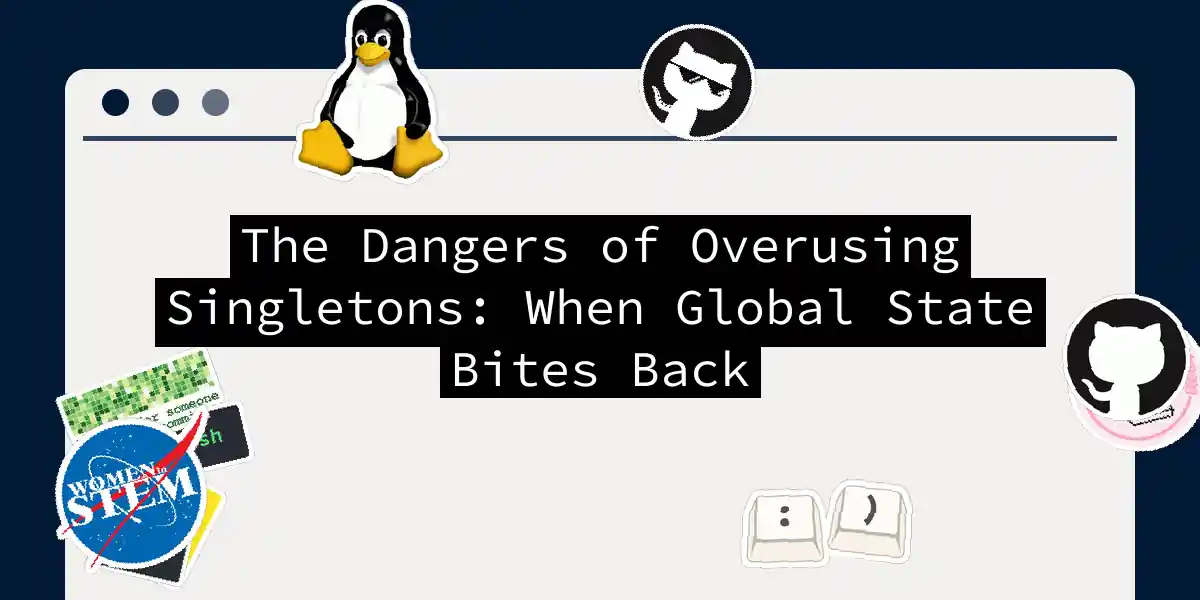Picture this: You’re sailing smoothly through your codebase when suddenly—chomp—a hidden global state sinks your project. That’s the Singleton pattern for you: the Jaws of software design. While it promises controlled access, it often drags your code into murky waters of hidden dependencies and testing nightmares. Let’s dissect why this “convenient” pattern can become your worst nightmare.
The Siren Song of Singletons
Singletons tempt us with sweet promises:
- “Just one instance, I swear!” (like a cookie jar labeled “staff only”)
- Global access point (the developer equivalent of leaving your car keys in the ignition)
- Lazy initialization (procrastination dressed as optimization) Here’s that seductive JavaScript skeleton we’ve all written:
class DatabaseConnection {
static instance;
constructor() {
if (DatabaseConnection.instance) {
return DatabaseConnection.instance;
}
this.connection = createConnection();
DatabaseConnection.instance = this;
}
}
Looks harmless, right? That’s what the pattern wants you to think. But let’s dive deeper.
When the Bite Comes: Real Consequences
1. Global State: The Silent Killer
Singletons create invisible tentacles throughout your codebase. Consider this logger “helper”:
// In fileA.js
Logger.instance.log("Started process");
// In fileB.js
Logger.instance.log("Completed step");
Seems clean until:
- Race conditions during initialization
- Unpredictable state mutations when multiple components tinker with it
- Debugging hell when logs magically stop working because someone reset the instance
2. Testing Quicksand
Try unit-testing this:
class PaymentProcessor {
process() {
const config = ConfigSingleton.instance.getSettings();
// Uses global config
}
}
You’ll need:
- Mock the singleton
- Reset state between tests
- Pray no tests run in parallel Suddenly, what should be a 5-minute test becomes a 50-minute configuration nightmare.
3. Scalability Sabotage
That “single instance” becomes a bottleneck when:
- Your app grows horizontally
- Serverless functions spawn instances
- Concurrent requests fight over resources Like trying to fit an entire football team through a toddler’s play tunnel.
Alternative Lifelines
Dependency Injection: The Adult Supervision
Replace global access with explicit dependency passing:
// Before (Singleton hell)
class UserService {
constructor() {
this.db = DatabaseSingleton.instance;
}
}
// After (DI paradise)
class UserService {
constructor(db) {
this.db = db;
}
}
Pros:
- Testable: Pass mock databases
- Flexible: Switch SQL for NoDB effortlessly
- Honest dependencies: No hidden relationships
Step-by-Step Refactoring Guide
- Identify singleton dependencies
Search forSingleton.instancereferences - Create constructor parameters
// BEFORE class OrderProcessor { constructor() { this.payment = PaymentGateway.instance; } } // AFTER class OrderProcessor { constructor(paymentGateway) { this.payment = paymentGateway; } } - Wire at composition root
// Top-level application setup const payment = new PaymentGateway(); const processor = new OrderProcessor(payment); - Eliminate static instance
Remove thestatic instancecode from singleton classes
When Singletons Might Not Bite
Rare legitimate cases exist:
- True single resources (hardware controllers)
- Cross-cutting concerns (logging where DI is impractical) But even then—handle with asbestos gloves.
The Architectural Ripple Effect
See those arrows? That’s your future technical debt accumulating.
Conclusion: Swim Safely
Like chocolate cake, singletons are fine in microscopic doses but disastrous as your main diet. They promise shortcuts but deliver obstacle courses. Next time you reach for that getInstance(), ask: “Is this worth trading testability for temporary convenience?” Your future self debugging at 2 AM will thank you.
What’s your most painful singleton horror story? Share below and let’s commiserate! 🦈
*Note: All code examples use JavaScript for universal relevance, but principles apply across languages.*
